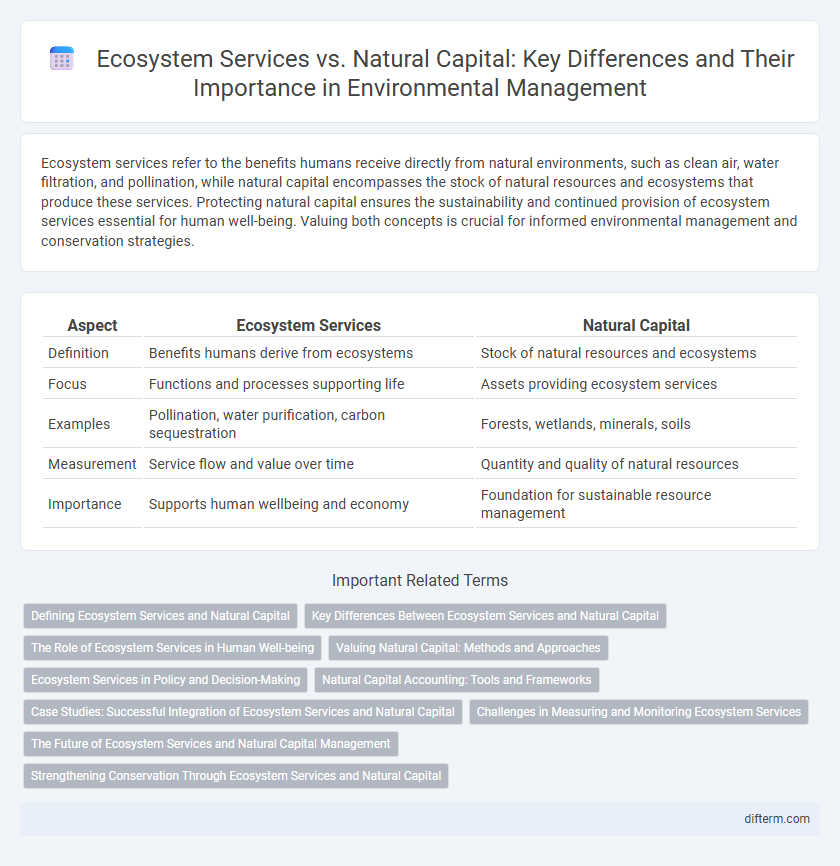Ecosystem services refer to the benefits humans receive directly from natural environments, such as clean air, water filtration, and pollination, while natural capital encompasses the stock of natural resources and ecosystems that produce these services. Protecting natural capital ensures the sustainability and continued provision of ecosystem services essential for human well-being. Valuing both concepts is crucial for informed environmental management and conservation strategies.
Table of Comparison
| Aspect | Ecosystem Services | Natural Capital |
|---|---|---|
| Definition | Benefits humans derive from ecosystems | Stock of natural resources and ecosystems |
| Focus | Functions and processes supporting life | Assets providing ecosystem services |
| Examples | Pollination, water purification, carbon sequestration | Forests, wetlands, minerals, soils |
| Measurement | Service flow and value over time | Quantity and quality of natural resources |
| Importance | Supports human wellbeing and economy | Foundation for sustainable resource management |
Defining Ecosystem Services and Natural Capital
Ecosystem services refer to the benefits humans obtain from natural ecosystems, including provisioning services such as food and water, regulating services like climate regulation and flood control, and cultural services encompassing recreational and spiritual benefits. Natural capital represents the world's stock of natural resources, such as soil, water, air, flora, and fauna, that provide ecosystem services and support human well-being. Understanding the distinction between ecosystem services as flows of benefits and natural capital as the stock underpinning these benefits is crucial for sustainable environmental management.
Key Differences Between Ecosystem Services and Natural Capital
Ecosystem services refer to the tangible benefits humans derive from natural ecosystems, such as pollination, water purification, and climate regulation, while natural capital represents the stock of natural resources like forests, minerals, and water bodies that generate these services. Key differences lie in their conceptual focus: natural capital emphasizes the resource base itself, whereas ecosystem services highlight the direct functional advantages provided to human well-being. Understanding this distinction is essential for effective environmental management and sustainable development planning.
The Role of Ecosystem Services in Human Well-being
Ecosystem services, including provisioning, regulating, and cultural benefits, directly support human well-being by sustaining vital resources such as clean air, water, and fertile soil. These services contribute to health, food security, and economic stability, forming a critical link between natural capital and societal prosperity. Protecting and managing ecosystem services enhances resilience to environmental changes and promotes sustainable development.
Valuing Natural Capital: Methods and Approaches
Valuing natural capital involves quantifying the benefits ecosystems provide, such as provisioning, regulating, cultural, and supporting services. Methods include market-based valuation, cost-benefit analysis, and ecosystem service modeling to assess economic contributions and inform sustainable management. Challenges persist in capturing non-market values and integrating ecological complexity into decision-making frameworks.
Ecosystem Services in Policy and Decision-Making
Ecosystem services provide quantifiable benefits such as clean air, water filtration, and pollination that directly support human well-being and economic development, making them critical for informed policy and decision-making. Integrating ecosystem services into environmental regulations helps prioritize conservation efforts based on their contribution to public health and sustainable resource management. Valuing these services in policy frameworks promotes resilience against climate change and biodiversity loss by aligning economic incentives with ecological preservation.
Natural Capital Accounting: Tools and Frameworks
Natural Capital Accounting (NCA) provides standardized tools and frameworks for quantifying and valuing ecosystem services and natural capital assets, enabling better integration into economic decision-making. Frameworks like the System of Environmental-Economic Accounting (SEEA) offer comprehensive methods to assess natural capital stocks, flows, and degradation impacts within national accounts. These approaches facilitate sustainable resource management by linking ecological data with financial metrics, improving policy design for environmental conservation and economic development.
Case Studies: Successful Integration of Ecosystem Services and Natural Capital
Case studies demonstrating successful integration of ecosystem services and natural capital reveal significant improvements in biodiversity conservation, water regulation, and carbon sequestration. Projects in the Amazon Basin and the Mekong River delta showcase how valuing natural capital leads to sustainable resource management and enhanced ecosystem resilience. These examples highlight the crucial role of policy frameworks and community engagement in aligning economic incentives with ecological health.
Challenges in Measuring and Monitoring Ecosystem Services
Challenges in measuring and monitoring ecosystem services stem from the complexity and variability of natural processes, making it difficult to assign precise economic values to these services. The integration of biophysical data with socioeconomic indicators often lacks standardized methodologies, leading to inconsistencies in ecosystem service assessments. Furthermore, limited spatial and temporal data hinder accurate tracking of changes in ecosystem services, complicating conservation and policy decision-making.
The Future of Ecosystem Services and Natural Capital Management
Emerging advancements in remote sensing and AI-driven analytics enhance the precision of ecosystem services valuation, driving more informed natural capital management strategies. Integrating nature-based solutions within urban planning and climate adaptation frameworks ensures sustainable provisioning, regulating, and cultural services for future generations. Robust policy frameworks coupled with cross-sector collaboration are essential to balance economic growth with ecosystem resilience and biodiversity conservation.
Strengthening Conservation Through Ecosystem Services and Natural Capital
Ecosystem services quantify the benefits that natural capital--such as forests, wetlands, and oceans--provides to humanity, enabling more precise valuation and targeted conservation efforts. Strengthening conservation initiatives through ecosystem service assessment ensures sustainable resource management by linking ecological health directly to economic and social well-being. Investing in natural capital preservation enhances biodiversity resilience, climate regulation, and water purification, which are critical for maintaining ecosystem functionality and long-term environmental stability.
ecosystem services vs natural capital Infographic

 difterm.com
difterm.com